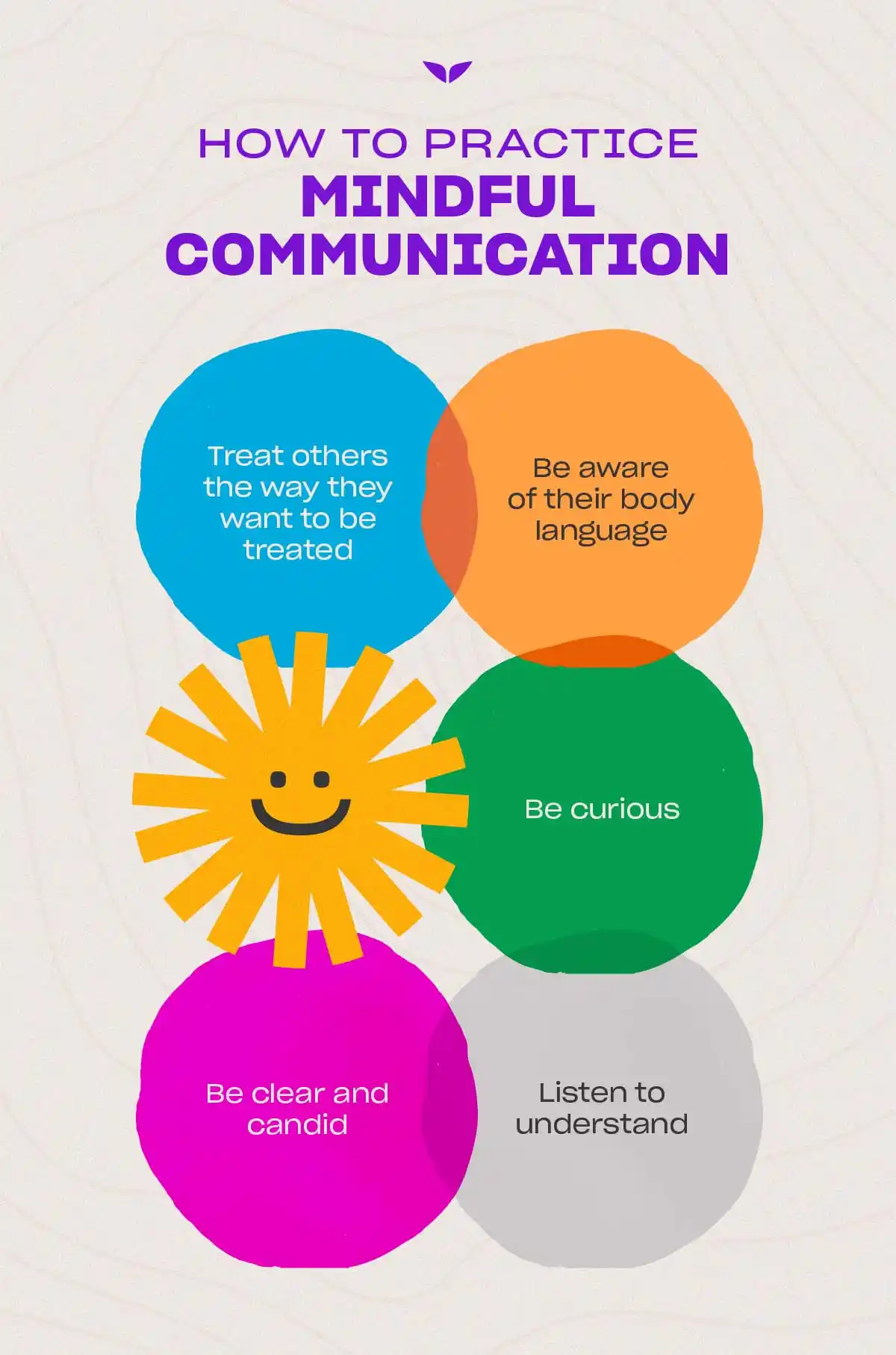“How you doin’?” might be one of the most iconic lines in television history. It’s witty, it’s charming, and, surprisingly, it’s mindful.
Wait…what? How is Joey from Friends’ pickup line possibly mindful?
That’s the thing many of us aren’t aware of—mindful communication isn’t only listening intently. There are other aspects that make it so enriching.
“It requires you to be intentional, vulnerable, and respectful so you can create a safe space to connect,” says Neelam Verma, the founder of Integrity Dating and trainer of Mindvalley’s Finding Love with Integrity Dating Quest.
When you do, you open up a whole new world—one with fewer misunderstandings, fewer frustrations, and more meaningful (not to mention deeper) relationships.
What is mindful communication?
Mindfulness is being in the moment, paying attention to what’s going on around you and within you without judgment or distraction. Take that concept and apply it to the interactions you have with others, and that, in a nutshell, is mindful communication.
Like Joey’s famous line—it may seem like a simple pickup line, but part of its charm comes from being fully present. He wasn’t just spitting out words; he was connecting in the moment, which is a core part of mindful communication.
It fosters understanding, empathy, and mutual respect. In fact, research shows that mindful communication can help people cooperate better by increasing acceptance and understanding in conversations.
The thing with engaging with someone is, it’s your responsibility to deliver your message in a way that the other person understands what you’re trying to say. What’s more, it’s also your responsibility to listen so that you understand what they’re trying to say. (And vice versa, of course.)
8 principles
In a study about mindfulness and leadership, researchers found that when leaders used mindful communication, their team members felt more satisfied. This shows how mindful conversations can really improve relationships.
That’s why, with mindful communication, it’s important to follow these eight principles:
- Listening actively,
- Paying attention to verbal and nonverbal cues,
- Interacting without judgment or preconceived notions,
- Being in the moment,
- Showing cognitive empathy,
- Expressing yourself clearly and thoughtfully,
- Taking the time to let conversations unfold naturally, and
- Being open to the perspectives of others.
As career coach Rafa Sarandeses says in Michael Thompson’s Shy by Design, “Our time isn’t the greatest gift we can give to someone; our presence is.”
The importance of being mindful in communication
There’s one thing that Michael does point out in his book, and it’s this: “The most valuable people take the time to understand what other people value. They’re supportive. They’re interested. They listen.”
That’s what communicating mindfully is about. It allows for more authentic, conscious interactions where both you and the other person feel heard and valued.
What’s more, it enhances emotional intelligence. This means you and the other person better manage your reactions and responses.
In doing so, you’re likely to respect and trust one another. You’re likely to improve conflict resolution. You’re likely to foster healthier, more supportive relationships.
“Conscious conversations lead to conscious relationships,” explains Neelam. “Conscious relationships are relationships where two people come together as partners and growth fully expressed. They co-create a beautiful and fulfilling relationship.”
Granted, she’s talking about mindfulness in relationships (or the potential of it). However, what is that but just two people learning how to have in-the-moment conversations so that there’s a safe space to build a meaningful bond?
And if Joey’s “How you doin’?” taught us anything, it’s that even the simplest (albeit corniest) lines, when said with genuine attention, can spark a connection.
The bottom line is, it’s not always about the words; it’s the intention behind them. That’s the power of mindful communication—it turns casual moments into opportunities for something deeper.
How to practice mindful communication
Short of “How you doin’?” it to everyone you meet (and, to be frank, no one’s interested in a copycat), here are some communication skills you can brush up on to make your conversations more thoughtful, engaging, and authentic.

1. Treat others the way they want to be treated
The saying goes, “Treat others the way you want to be treated.” However, Vanessa Van Edwards, a speaker with Science of People and the trainer of Mindvalley’s Magnetic Charisma Quest, says otherwise. She says, “Treat others the way they want to be treated.”
What does that mean?
Well, research has found that 30–60% of our personality is genetic. That means, when you interact with others, it’s important to recognize that their personality traits aren’t easily changed—they’re a part of who they are.
In her Mindvalley Quest, Vanessa explains that when you understand and respect these traits, you can adapt the way you communicate to meet their needs.
For example, a friend who thrives on routine and predictability—“they like to do the same thing for dinner, watch the same show, on the same couch, with the same snack, in the same blanket”—may not appreciate spontaneity. On the other hand, a friend who craves adventure may feel stifled by too much predictability.
This approach shows you’re being more mindful and considerate in your interactions. That can help build stronger bonds.
2. Be aware of their body language
They lean back, they lean in, they’re yawning, their leg is twitching… So much talking without even saying a word.
You, too, project. The way you stand, move, or make eye contact can convey messages that may or may not align with what’s coming out of your mouth.
According to Michael in Shy by Design, it’s important to make the other person feel comfortable rather than trying to project confidence. Like standing to the side, adopting a relaxed posture, a gentle smile, or taking your time when you speak.
“There are times when speaking quickly can help you come off as more knowledgeable or confident,” he writes. “Even though it may work in a debate, this strategy can backfire when meeting someone new.”
Remember, people need time to assess both your words and actions. So, instead of coming on too strong, try, instead, to mirror their body language. It builds rapport and helps create an atmosphere where everyone feels more at ease.
3. Be clear and candid
“Transparency and openness and candor—that really doesn’t exist to the extent that it should,” says Keith Ferrazzi, the founder and CEO of Ferrazzi Greenlight, in his Ultimate Leadership Quest on Mindvalley.
He emphasizes that being clear and candid is essential for strong, trusting relationships. It means sharing your thoughts honestly.
It’ll take a level of self-awareness, for sure, especially since it’s likely to be uncomfortable or risky. But here’s the thing: sugarcoating or avoiding tough topics can lead to misunderstandings. So, when you’re giving feedback to someone, address them directly but with kindness.
What’s more, you make space for the other person to share their true thoughts and ideas. This openness can lead to stronger collaboration, fewer misunderstandings, and deeper connections in both your personal and professional relationships.
4. Listen to understand
“Society as a whole has a problem with silence,” says Warren Schaefer, a three-time startup founder, in Shy by Design.
The thing is, many of us have been taught to listen to respond. But what we should be doing is listening to understand.
This mindful listening takes a certain kind of confidence—something Michael calls “quiet confidence.”
It’s the kind where you don’t feel the need to always speak or push your point across. It’s also about creating trust so everyone involved in the conversation feels safe to share openly. In essence, it’s when you “just listen and let others talk.”
This will allow the other person to feel heard and valued. Additionally, you also learn more about them, which can deepen the conversation and lead to more thoughtful, meaningful exchanges.
5. Be curious
Curiosity may have killed the cat. When it comes to mindful communication, though, it’s the thing that brings conversations to life.
“Meaningful questions are the ones that can help you know someone’s heart and soul,” says Neelam. So what do you want to know? What do you want to share? (Or, in Joey’s case, “How you doin’?”)
In his book, Michael tells the story of his one-on-one with Denise Young Smith, the former Chief of Human Resources at Apple. She was genuinely interested in his work and wanted to get to the heart of who he was.
One tip he noticed that she used was padding statements. These are prompts like “I’m curious…”, “I never thought of it that way…”, or “That’s interesting…”
“Without the prompts, the questions can come off as harsh or abrupt,” Michael explains. “These transitionary statements help make the conversation more fluid.”
When you approach every conversation not only with mindful listening but also with curiosity, you help bring out the stories of others. That sets the stage for your interactions to flow naturally and uncover insights that you might’ve otherwise missed.
Mindful communication in the workplace
When it comes to any kind of relationship, even professional ones, there are three words you must know: Communication is key.
“The kind of communication,” Keith says in his Mindvalley Quest, “that includes the willingness to challenge and speak your mind, and be bold, and maybe even have a bit more candor than what you normally would have.”
As a matter of fact, a study at Stanford University identified the traits of the most successful MBA students. What they found is that verbal fluency, not grade point average, is the common trait.
So if being able to have open, clear discussions creates a strong team dynamic, what are the steps you can take to do so? Here are some mindful communication exercises Keith recommends:
- The “Yoda Moment.” A few team members are designated to point out unspoken thoughts or potential risks during meetings. This simple yet powerful activity allows for more transparency and ensures that important ideas are not missed.
- Dial Up, Dial Down. It helps you reflect on how you communicate—whether you need to speak up more (“dial up”) or listen more and interrupt less (“dial down”). This practice encourages self-awareness and thoughtful adjustments to your communication style, making interactions more effective and mindful.
- Check-ins. Give team members a space to be vulnerable and share both their personal and professional challenges. By opening up in this way, teams create deeper connections and establish a foundation of trust, making it easier for everyone to communicate openly.
“If someone feels disrespected or unheard, they’re not going to communicate,” Keith points out. “They’re going to stay quiet, and you don’t want that.”
So remember: if your team member says something, consider and validate their efforts. It’ll make a world of difference.
Become a changemaker
While it does have the word “communication” in it, mindful communication isn’t solely about talking. It’s also about listening, understanding, and creating a space where everyone feels heard.
So, why not make each interaction count? After all, the more mindful you are in how you talk to people, the better your relationships will be—both at work and at home.
If you’re looking for an easy way to spark deeper, more meaningful connections, The Connection Kit is a great tool to have on hand—plus, it’s free and instantly accessible.
The deck is packed with thoughtful conversation starters (no, none of them are “How you doin’?”). With it, you can engage in truly mindful discussions, whether with your friends, your kids, your loved ones, your colleagues, or strangers.
Welcome in.











